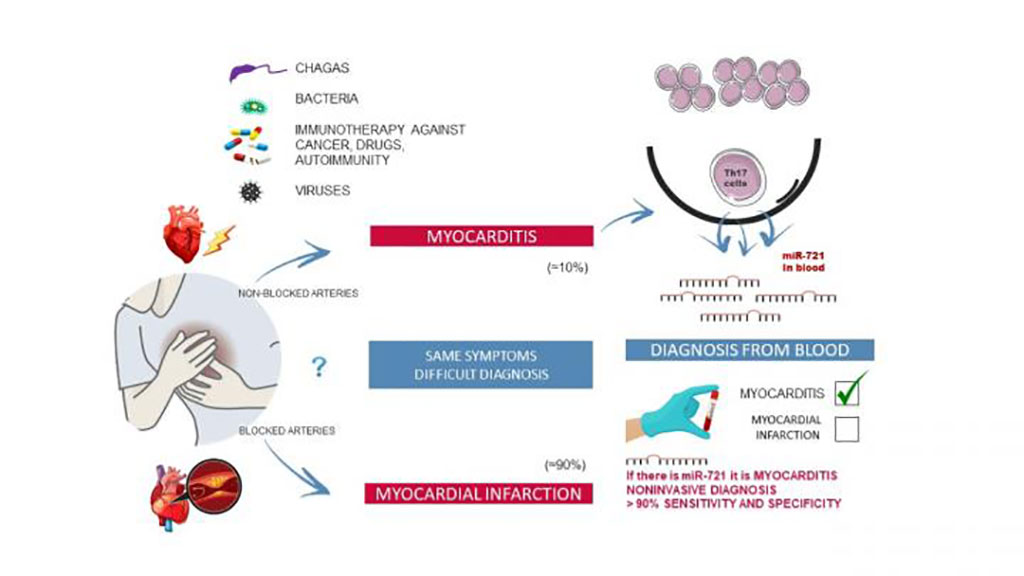Blood MicroRNA Biomarker Distinguishes Myocarditis from Myocardial Infarction
|
By LabMedica International staff writers Posted on 08 Jun 2021 |

Image: First biomarker in blood that distinguishes myocarditis from an acute myocardial infarction (Photo courtesy of Centro Nacional De Investigaciones Cardiovasculares)
A novel microRNA has been found that can be used to distinguish patients with myocarditis from those with myocardial infarction.
MiRNAs comprise a class of about 20 nucleotides-long RNA fragments that block gene expression by attaching to molecules of messenger RNA in a fashion that prevents them from transmitting the protein synthesizing instructions they had received from the DNA. With their capacity to fine-tune protein expression via sequence-specific interactions, miRNAs help regulate cell maintenance and differentiation. In addition to miRNAs playing an essential role in tumor development, dysregulation of certain miRNAs has been associated with many different diseases, such as dementia and cardiovascular conditions.
Myocarditis is usually diagnosed after coronary angiography or computed tomography scans have ruled out coronary artery disease, followed by confirmation of the diagnosis by magnetic resonance imaging (MRI). However, not all centers have access to MRI technology, and the current gold standard for myocarditis diagnosis is endomyocardial biopsy, an invasive procedure normally reserved for severe cases. Thus a pressing clinical need exists for the development of reliable and accessible tools for the early diagnosis of acute myocarditis.
In this regard, investigators at the Centro Nacional de Investigaciones Cardiovasculares (Madrid, Spain) and their collaborators in Spain and abroad sought to identify a novel microRNA for the diagnosis of acute myocarditis.
To identify a microRNA specific for myocarditis, they performed microRNA microarray analyses and quantitative polymerase-chain-reaction (qPCR) assays in sorted CD4+ T cells and type 17 helper T (Th17) cells after inducing experimental autoimmune myocarditis or myocardial infarction in mice. They then identified the human homologue for this microRNA and compared its expression in plasma obtained from patients with acute myocarditis with the expression in various controls.
Results revealed that the human homologue, designated hsa-miR-Chr8:96, could be identified in four independent cohorts of patients with myocarditis. The area under the receiver-operating-characteristic curve for this novel microRNA for distinguishing patients with acute myocarditis from those with myocardial infarction was 0.927. The microRNA retained its diagnostic value in models after adjustment for age, sex, ejection fraction, and serum troponin level.
"Our finding has great potential as a valuable clinical tool for the precise and noninvasive diagnosis of myocarditis from small drops of blood," said senior author Dr. Pilar Martín, a research professor at the Centro Nacional de Investigaciones Cardiovasculares.
The myocarditis paper was published in the May 27, 2021, online edition of The New England Journal of Medicine.
Related Links:
Centro Nacional de Investigaciones Cardiovasculares
MiRNAs comprise a class of about 20 nucleotides-long RNA fragments that block gene expression by attaching to molecules of messenger RNA in a fashion that prevents them from transmitting the protein synthesizing instructions they had received from the DNA. With their capacity to fine-tune protein expression via sequence-specific interactions, miRNAs help regulate cell maintenance and differentiation. In addition to miRNAs playing an essential role in tumor development, dysregulation of certain miRNAs has been associated with many different diseases, such as dementia and cardiovascular conditions.
Myocarditis is usually diagnosed after coronary angiography or computed tomography scans have ruled out coronary artery disease, followed by confirmation of the diagnosis by magnetic resonance imaging (MRI). However, not all centers have access to MRI technology, and the current gold standard for myocarditis diagnosis is endomyocardial biopsy, an invasive procedure normally reserved for severe cases. Thus a pressing clinical need exists for the development of reliable and accessible tools for the early diagnosis of acute myocarditis.
In this regard, investigators at the Centro Nacional de Investigaciones Cardiovasculares (Madrid, Spain) and their collaborators in Spain and abroad sought to identify a novel microRNA for the diagnosis of acute myocarditis.
To identify a microRNA specific for myocarditis, they performed microRNA microarray analyses and quantitative polymerase-chain-reaction (qPCR) assays in sorted CD4+ T cells and type 17 helper T (Th17) cells after inducing experimental autoimmune myocarditis or myocardial infarction in mice. They then identified the human homologue for this microRNA and compared its expression in plasma obtained from patients with acute myocarditis with the expression in various controls.
Results revealed that the human homologue, designated hsa-miR-Chr8:96, could be identified in four independent cohorts of patients with myocarditis. The area under the receiver-operating-characteristic curve for this novel microRNA for distinguishing patients with acute myocarditis from those with myocardial infarction was 0.927. The microRNA retained its diagnostic value in models after adjustment for age, sex, ejection fraction, and serum troponin level.
"Our finding has great potential as a valuable clinical tool for the precise and noninvasive diagnosis of myocarditis from small drops of blood," said senior author Dr. Pilar Martín, a research professor at the Centro Nacional de Investigaciones Cardiovasculares.
The myocarditis paper was published in the May 27, 2021, online edition of The New England Journal of Medicine.
Related Links:
Centro Nacional de Investigaciones Cardiovasculares
Latest Molecular Diagnostics News
- New Biomarker Panel to Improve Heart Failure Diagnosis in Women
- Dual Blood Biomarkers Improve ALS Diagnostic Accuracy
- Automated Test Distinguishes Dengue from Acute Fever-Causing Illnesses In 18 Minutes
- High-Sensitivity Troponin I Assay Aids in Diagnosis of Myocardial Infarction
- Fast Low-Cost Alzheimer’s Tests Could Detect Disease in Early and Silent Stages
- Further Investigation of FISH-Negative Tests for Renal Cell Carcinoma Improves Diagnostic Accuracy
- First Direct Measurement of Dementia-Linked Proteins to Enable Early Alzheimer’s Detection
- New Diagnostic Method Detects Pneumonia at POC in Low-Resource Settings
- Blood Immune Cell Analysis Detects Parkinson’s Before Symptoms Appear
- New Diagnostic Marker for Ovarian Cancer to Enable Early Disease Detection

- Urine Test Detects Early Stage Pancreatic Cancer
- Genomic Test Could Reduce Lymph Node Biopsy Surgery in Melanoma Patients
- Urine Test Could Replace Painful Kidney Biopsies for Lupus Patients
- Blood Test Guides Post-Surgical Immunotherapy for Muscle-Invasive Bladder Cancer
- Mitochondrial DNA Mutations from Kidney Stressors Could Predict Future Organ Decline
- Blood Test Could Predict Bariatric Surgery Outcomes in Teenagers
Channels
Clinical Chemistry
view channel
VOCs Show Promise for Early Multi-Cancer Detection
Early cancer detection is critical to improving survival rates, but most current screening methods focus on individual cancer types and often involve invasive procedures. This makes it difficult to identify... Read more
Portable Raman Spectroscopy Offers Cost-Effective Kidney Disease Diagnosis at POC
Kidney disease is typically diagnosed through blood or urine tests, often when patients present with symptoms such as blood in urine, shortness of breath, or weight loss. While these tests are common,... Read moreHematology
view channel
ADLM’s New Coagulation Testing Guidance to Improve Care for Patients on Blood Thinners
Direct oral anticoagulants (DOACs) are one of the most common types of blood thinners. Patients take them to prevent a host of complications that could arise from blood clotting, including stroke, deep... Read more
Viscoelastic Testing Could Improve Treatment of Maternal Hemorrhage
Postpartum hemorrhage, severe bleeding after childbirth, remains one of the leading causes of maternal mortality worldwide, yet many of these deaths are preventable. Standard care can be hindered by delays... Read more
Pioneering Model Measures Radiation Exposure in Blood for Precise Cancer Treatments
Scientists have long focused on protecting organs near tumors during radiotherapy, but blood — a vital, circulating tissue — has largely been excluded from dose calculations. Each blood cell passing through... Read moreImmunology
view channel
Chip Captures Cancer Cells from Blood to Help Select Right Breast Cancer Treatment
Ductal carcinoma in situ (DCIS) accounts for about a quarter of all breast cancer cases and generally carries a good prognosis. This non-invasive form of the disease may or may not become life-threatening.... Read more
Blood-Based Liquid Biopsy Model Analyzes Immunotherapy Effectiveness
Immunotherapy has revolutionized cancer care by harnessing the immune system to fight tumors, yet predicting who will benefit remains a major challenge. Many patients undergo costly and taxing treatment... Read moreMicrobiology
view channel
15-Minute Blood Test Diagnoses Life-Threatening Infections in Children
Distinguishing minor childhood illnesses from potentially life-threatening infections such as sepsis or meningitis remains a major challenge in emergency care. Traditional tests can take hours, leaving... Read more
High-Throughput Enteric Panels Detect Multiple GI Bacterial Infections from Single Stool Swab Sample
Gastrointestinal (GI) infections are among the most common causes of illness worldwide, leading to over 1.7 million deaths annually and placing a heavy burden on healthcare systems. Conventional diagnostic... Read morePathology
view channel
AI Tool Improves Accuracy of Skin Cancer Detection
Diagnosing melanoma accurately in people with darker skin remains a longstanding challenge. Many existing artificial intelligence (AI) tools detect skin cancer more reliably in lighter skin tones, often... Read more
Highly Sensitive Imaging Technique Detects Myelin Damage
Damage to myelin—the insulating layer that helps brain cells function efficiently—is a hallmark of many neurodegenerative diseases, age-related decline, and traumatic injuries. However, studying this damage... Read moreTechnology
view channel
Portable Biosensor Diagnoses Psychiatric Disorders Using Saliva Samples
Early diagnosis of psychiatric disorders such as depression, schizophrenia, and bipolar disorder remains one of medicine’s most pressing challenges. Current diagnostic methods rely heavily on clinical... Read more
Cell-Sorting Device Uses Electromagnetic Levitation to Precisely Direct Cell Movement
Sorting different cell types—such as cancerous versus healthy or live versus dead cells—is a critical task in biology and medicine. However, conventional methods often require labeling, chemical exposure,... Read moreIndustry
view channel
Co-Diagnostics Forms New Business Unit to Develop AI-Powered Diagnostics
Co-Diagnostics, Inc. (Salt Lake City, UT, USA) has formed a new artificial intelligence (AI) business unit to integrate the company's existing and planned AI applications into its Co-Dx Primer Ai platform.... Read more
























